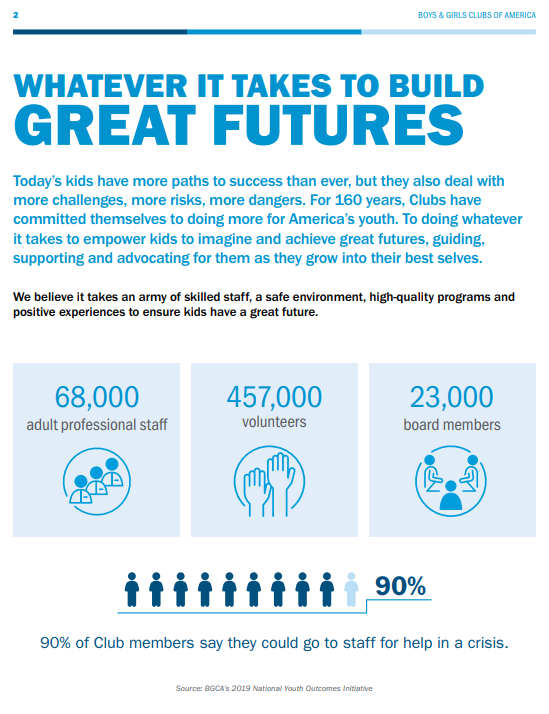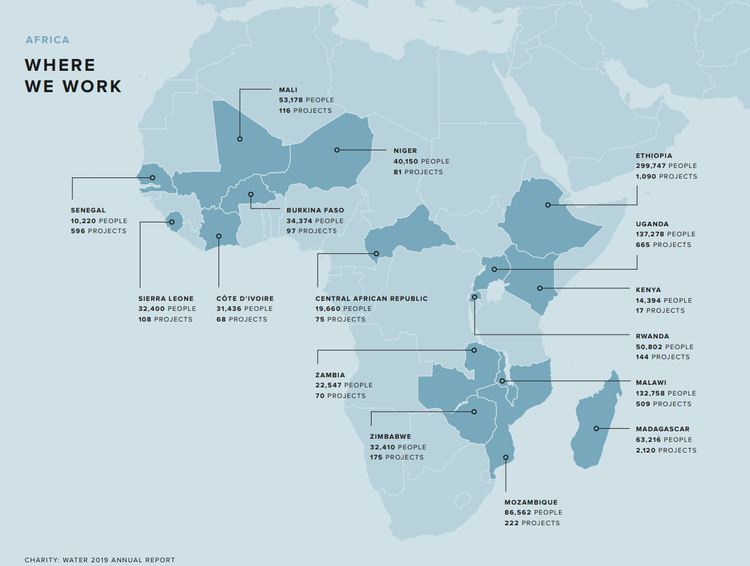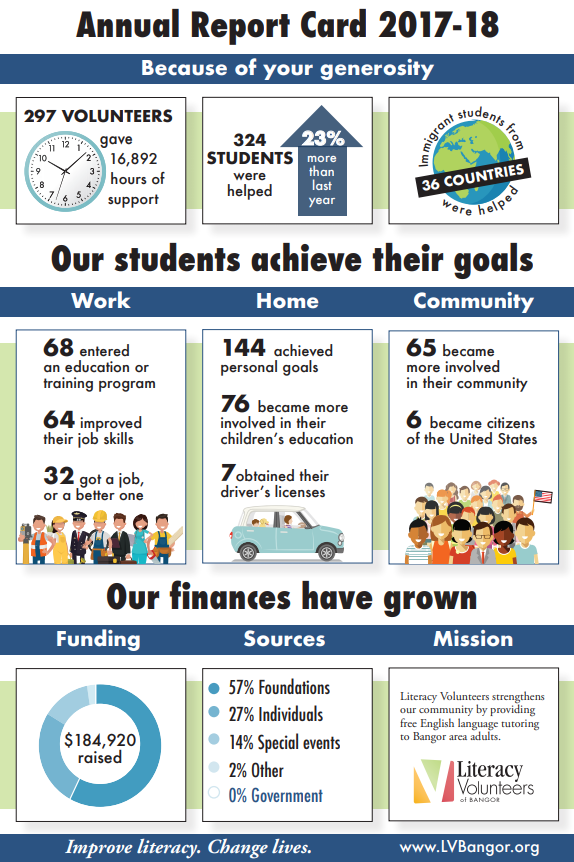How to Drive Impact With Your Nonprofit Annual Report
When you’re already juggling year-end fundraising campaigns, grant reporting requirements, holiday schedules, and more, allocating time for a nonprofit annual report may seem superfluous. Especially in year one, when your team is focused on the details of how to start a nonprofit, you might be inclined to skip this annual summary.
However, effective nonprofit annual reports can elevate each of your other tasks and build momentum for your nonprofit’s continued success.
The time you set aside to develop and distribute a nonprofit annual report acts as an opportunity for strategic planning, donor stewardship, and auditing your nonprofit accounting. It also fosters a culture of transparency, accountability, and trust between your nonprofit and past, current, and prospective donors.
In this article, we’ll cover exactly what to include in your report, tips for making it stand out to your stakeholders, and examples of some of the best nonprofit annual reports out there.
Overview: What is a nonprofit annual report?
A nonprofit annual report is a summary of the impact your nonprofit has had over the last year and where it’s headed next. It’s a chance to thank your supporters and clearly communicate about how their donations translated into mission-driven results.
The report should encourage repeat gifts in the coming year from past donors and introduce your nonprofit to prospective donors in a way that inspires them to join your cause.
What is included in a nonprofit annual report?
Nonprofit annual reports allow plenty of room to get creative and show your nonprofit’s story through both visuals and text. However, before focusing on innovative ways to convey your nonprofit’s brand, make sure to include the following core elements of a nonprofit annual report.
1. Name, mission, vision, and values
Your organization’s name and logo should be front and center on the report’s cover. This allows supporters to quickly identify your brand and connect with the content. Once they open the report, having your nonprofit’s mission, vision, and values at the beginning of the document further serves to draw them into your purpose and why they should care about it.
There’s also a chance people unfamiliar with your nonprofit may access your free annual report. Providing these core elements early on is crucial for introducing yourself to those prospective donors.
2. Key staff and board leadership
Humanize your nonprofit by listing the names of key staff and board members. You can also include a team photo or other visuals to show your donors the faces behind your work.
Depending on the size of your nonprofit and the space available in your report, you may also wish to include a few short staff bios or profiles to highlight the expertise of your team. This demonstrates to supporters that you take care to hire the most qualified candidates.
3. Basic financial report
You must include a basic financial report in your nonprofit’s annual summary. This fund accounting fosters a culture of transparency and trust between you and your donors. People who give money to an organization want to know that it is being used wisely.
However, many readers of your report are not accountants. Therefore, keep your financial information straightforward and easy to understand for a lay audience. Report financial data that show:
- What sources your funding came from (e.g., government grants, foundations, individual donors, etc.)
- Where you allocated your funding throughout the year (e.g., overhead, direct programming, etc.)
- Any changes in budgets or fundraising goals between this year and last
Using pie charts, line graphs, and other visuals is an effective way to communicate financial data to your supporters. If donors want more detailed breakdowns, remind them that they can always reach out to your team.
4. Accomplishment-focused project descriptions
Your nonprofit annual report should describe your organization’s projects and programming. Include details on which activities you completed during the reporting year and timelines for completing any ongoing work.
To center this section on impact, write your project descriptions with a focus on what they’ve accomplished. For example, if your nonprofit runs a winter coat drive for families experiencing homelessness, rather than tell donors about the program, show them with your data. Your description might read like this:
5. Impact data
While some of your impact data will appear in your project descriptions -- as in the previous example -- you should also include high-level data that demonstrate changes over time, beneficiary satisfaction levels, and overall measures toward your goals. These data could include figures such as:
- Ninety-seven percent of youth who completed our mentorship program reported feeling more confident.
- Between 2019 and 2020, our river cleanup program removed 10 tons of trash from local wetlands. As a result, our wildlife distress hotline saw a 67% drop in calls related to animals tangled in plastic litter.
- For every $10 we raised this year, we were able to provide clean drinking water to 20 families in need.
Consider displaying these data in an infographic or in other visually appealing ways. In the example below, the Boys & Girls Clubs of America highlights the impact of its staff, board, and volunteers by showcasing key numbers alongside simple graphics. This creates a more engaging section than if the data were simply listed within a paragraph of text.

The Boys & Girls Clubs of America's 2019 annual report displays staff and volunteer data using simple graphics. Image source: Author
In addition to numerical data, show your impact through storytelling. You can include success stories from beneficiaries or display pull-out quotes from people expressing their gratitude for how your nonprofit helped them or their community. Weaving in this qualitative impact data adds an emotional element that captures your audience and inspires them to give.
6. Thank-yous to donors, partners, and other champions
In many ways, you should think of your nonprofit’s annual report as a big thank-you letter. You are sharing your impact, future vision, and financial data -- all in the spirit of showing your donors and partners what they made possible and can continue to make possible in the next year.
Use language throughout your report that centers on your nonprofit’s champions and shows gratitude for their donations, such as:
- Your generous support allowed us to feed more than 1,200 families in our community this year.
- Thanks to you, we were able to protect 800 acres of greenspace critical for migrating bird populations.
You can also use a few pages to list your donors by name. If your nonprofit is smaller, it might make sense to list the names of everyone who donated that year. For larger nonprofits, you may choose to list the names of anyone who donated more than a certain amount, such as $5,000 or more. Make sure to include any local business partners or other stakeholders who provided key financial or in-kind support during the year.
7. A call to action
Your nonprofit annual report might be a summary of what you accomplished in the past year, but it’s also your call to action for the next year. Use your report to look forward. What types of fundraising efforts will you be emphasizing in the future (e.g., peer-to-peer, foundation support, etc.)? What programs are you looking to fund, and how will they support your overall mission?
Make sure to leave your audience with clear steps for how they can help with your next initiative and a reminder of where they can make their donation.
5 tips for creating your own nonprofit annual report
Once you’ve gathered the key elements for your nonprofit annual report, you can consider:
- How to style and format the report
- Ways to use data and storytelling to capture your brand
- What nonprofit software can help you bring it all together
The following tips can help your team create an effective annual report that guides your nonprofit’s growth and inspires your supporters.
1. Speak to your audience
Your nonprofit annual report should be accessible to a wide audience regardless of their level of knowledge within your field. Avoid industry jargon and acronyms that can confuse readers and muddle your message. If you need to use some special terms, include a glossary or acronym chart to introduce your readers to the information. Overall, focus on a casual, warm, and conversational tone.
2. Consider your format
Historically, nonprofit annual reports have taken the format of booklets ranging between 10 and 40 pages. There’s still an argument to be made for this style since research shows people have higher focus and reading comprehension with printed materials.
However, digital formats can be more budget-friendly while also expanding your reach. Additionally, shorter printed materials can capture the attention of supporters who don’t necessarily have time for your nonprofit’s full novella.
Some other annual report formats to consider include:
- Interactive mini-websites that you can link to from your nonprofit’s homepage
- Videos that highlight your year’s accomplishments and thank donors
- Postcards that provide a quick summary, with a link to more extensive information online
- PDF versions of your full annual report hosted on your website to save on printing costs
- One-pagers or brochures that make for easy mailers
You may consider segmenting your supporters into different groups and sending your full printed report only to higher-level donors or those who have expressed a preference for printed materials. You can track this information in your customer relationship management (CRM) software.
3. Have a promotion and distribution plan
Your annual report takes time and resources to develop. You want to make sure people see this showcase of your mission-driven impact. While planning for the release of your annual report, think about how you will promote it.
Writing a press release is one way to highlight some key figures and other newsworthy stories media outlets may be interested in reporting on, such as this example for Girls Who Code.
Another way to capture a larger audience is through a promotional video, particularly given that research suggests video will account for 82% of all internet traffic by 2022. As an example, the World Wildlife Fund’s Canada chapter created a short video highlighting its yearly accomplishments, which complements its larger annual report.
4. Call it something else
The term “annual report” has a corporate business feeling to it, which may not resonate with your audience. Your nonprofit annual report should have a social good feeling to it that roots readers into your cause. By changing your terminology, you could draw in more supporters.
For example, the Greater Pittsburgh Community Food Bank calls its annual report the Gratitude Report. The environmental nonprofit Ecojustice calls it the Victories Report, emphasizing the actions the organization took that year to help the planet. Other potential names include Impact Report, Community Report, or Donor Appreciation Report.
5. Leverage available design software
Your nonprofit annual report should look polished and in line with your brand ethos. There are many applications available to help you design visually appealing pages using your nonprofit’s style guide -- even if you’re not a professional designer.
Issuu, for example, allows you to convert static PDFs into flipbooks, like this Gratitude Report from the Oregon Zoo Foundation, as well as social media stories, marketing collaterals, and more.
Canva provides easy-to-use templates for your report, along with design tips and drag-and-drop features for creating graphics with your own photos and text.
Lucidpress also offers professionally designed templates that your nonprofit can customize to fit with your brand’s aesthetics.
4 nonprofit annual report examples to inspire you
It helps to review annual report examples from other nonprofits within your field when looking to develop or revamp your own. The four examples below showcase compelling ways to communicate your information.
1. Fresh Air Fund
The Fresh Air Fund provides its annual report as both its own landing page, as well as a downloadable PDF document. It taps into supporters’ emotions through images of children impacted through its camping programs.
The photography shows happy kids making summer memories, along with fun statistics from the year such as the nonprofit using 432 bags of marshmallows, 900 bars of chocolate, and 60 boxes of graham crackers. Those data communicate impact while giving the reader a smile.

The Fresh Air Fund's 2019 annual report emphasizes photos of children who benefited from the nonprofit's services, plus fun statistics from a summer of camping. Image source: Author
2. charity: water
The nonprofit charity: water works across multiple countries, running hundreds of projects to bring clean water to people who need it. Rather than have a text-heavy list of all of its programming, the group uses maps within its annual report to visually represent the year’s impact. This annual report is a great example for larger nonprofits needing to communicate wide-ranging information through digestible highlights.

The 2019 annual report from charity: water includes a map of Africa highlighting the countries where the nonprofit had projects throughout the year. Image source: Author
3. Literacy Volunteers of Bangor
This example from Literacy Volunteers of Bangor shows how your nonprofit can create an abridged annual report that fits onto a postcard. One side of the postcard provides supporters with an overview of the amount the nonprofit raised that year and the direct impact it made toward its mission.
The other side includes a brief thank-you note from the nonprofit’s executive director. The information is easy to scan through its use of visuals and clear organization.
Ideally, if you choose this format for your annual report, you will include a link to where donors can find additional details on your finances and programming. Doing so reiterates a commitment to transparency and accountability.

The front side of the annual report card sent to supporters by Literacy Volunteers of Bangor. Image source: Author
4. National Public Radio
In this annual report example from National Public Radio (NPR), the nonprofit uses a creative way to thank its supporters by including donor spotlights. In these spotlights, donors are recognized for their support and also explain in their own words why NPR matters to them.
Sprinkled throughout the report as full-page spreads, these spotlights create an authentic feeling of collaboration between donors and the nonprofit and show how this relationship is what will sustain NPR’s work in the next year.

NPR's 2019 annual report highlights a quote from one of the nonprofit's major donors expressing what it means to him. Image source: Author
Your nonprofit annual report can help you connect with donors and remain forward-focused
A nonprofit annual report is a critical element for your organization’s donor stewardship, strategic planning, and financial accountability. Through creative visual elements and emotional storytelling, you can capture new audiences while strengthening your relationship with current supporters. Use available industry examples to inspire your first annual report or improve your next one.
Alert: our top-rated cash back card now has 0% intro APR until 2025
This credit card is not just good – it’s so exceptional that our experts use it personally. It features a lengthy 0% intro APR period, a cash back rate of up to 5%, and all somehow for no annual fee! Click here to read our full review for free and apply in just 2 minutes.
Our Research Expert
We're firm believers in the Golden Rule, which is why editorial opinions are ours alone and have not been previously reviewed, approved, or endorsed by included advertisers. The Ascent, a Motley Fool service, does not cover all offers on the market. The Ascent has a dedicated team of editors and analysts focused on personal finance, and they follow the same set of publishing standards and editorial integrity while maintaining professional separation from the analysts and editors on other Motley Fool brands.
Related Articles
View All Articles